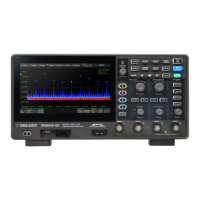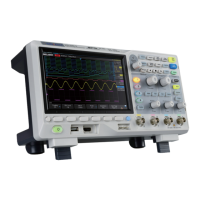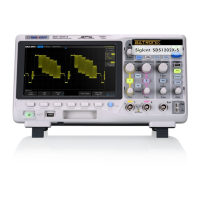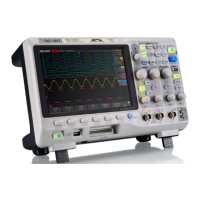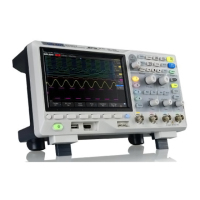Do you have a question about the SIGLENT SDS1204X HD and is the answer not in the manual?
Summary of precautions to avoid personal injury and instrument damage.
Explains safety terms and symbols used in the manual and on the instrument.
Outlines power input specifications and grounding requirements for safety.
Explains the trigger controls and modes (Auto, Single, Normal, Force).
Configuring acquisition modes, interpolation, and memory depth.
Details how to configure trigger settings via quick menu and dialog box.
Explains how to set the trigger level for accurate triggering.
Describes different trigger modes like Auto, Normal, Single, and Force.
Explains various trigger types available (Edge, Slope, Pulse, etc.).
Detailed guide for I2C trigger and decode setup.
Setting up triggers and decoding for SPI signals.
Setting up triggers and decoding for UART signals.
Setting up triggers and decoding for CAN signals.
Setting up triggers and decoding for LIN signals.
Instructions on selecting and moving cursors using gestures and the universal knob.
Overview of automatic measurements, statistics, and gate functions.
How to select and configure measurement parameters.
Details various measurement types: Vertical, Horizontal, and Miscellaneous.
How to configure and use measurement statistics.
Using the hardware frequency counter for accurate measurements.
Performing arithmetic operations like addition, subtraction, etc.
Performing advanced algebraic operations.
Applying digital filters to waveforms.
Methods for creating and setting up masks.
Defining rules (All In, All Out, Any In, Any Out) for pass/fail evaluation.
Overview of power analysis features and required accessories.
Analyzing power quality parameters like active power, power factor, etc.
Analyzing input current harmonics using FFT.
Measuring inrush current during power supply switching.
Calculating power dissipated during switching periods.
Measuring the rate of voltage or current change during switching.
Analyzing control pulse signals of switching devices.
Evaluating the quality of the DC power supply output voltage.
Measuring power supply turn-on and turn-off times.
Analyzing the response speed of output voltage to load changes.
Testing power supply rejection ratio to ripple noise.
Measuring the overall efficiency of the power supply.
Defining and testing Safe Operating Area (SOA) for MOSFETs.
Configuring DUT connection, sweep parameters, and generator settings.
Summary of precautions to avoid personal injury and instrument damage.
Explains safety terms and symbols used in the manual and on the instrument.
Outlines power input specifications and grounding requirements for safety.
Explains the trigger controls and modes (Auto, Single, Normal, Force).
Configuring acquisition modes, interpolation, and memory depth.
Details how to configure trigger settings via quick menu and dialog box.
Explains how to set the trigger level for accurate triggering.
Describes different trigger modes like Auto, Normal, Single, and Force.
Explains various trigger types available (Edge, Slope, Pulse, etc.).
Detailed guide for I2C trigger and decode setup.
Setting up triggers and decoding for SPI signals.
Setting up triggers and decoding for UART signals.
Setting up triggers and decoding for CAN signals.
Setting up triggers and decoding for LIN signals.
Instructions on selecting and moving cursors using gestures and the universal knob.
Overview of automatic measurements, statistics, and gate functions.
How to select and configure measurement parameters.
Details various measurement types: Vertical, Horizontal, and Miscellaneous.
How to configure and use measurement statistics.
Using the hardware frequency counter for accurate measurements.
Performing arithmetic operations like addition, subtraction, etc.
Performing advanced algebraic operations.
Applying digital filters to waveforms.
Methods for creating and setting up masks.
Defining rules (All In, All Out, Any In, Any Out) for pass/fail evaluation.
Overview of power analysis features and required accessories.
Analyzing power quality parameters like active power, power factor, etc.
Analyzing input current harmonics using FFT.
Measuring inrush current during power supply switching.
Calculating power dissipated during switching periods.
Measuring the rate of voltage or current change during switching.
Analyzing control pulse signals of switching devices.
Evaluating the quality of the DC power supply output voltage.
Measuring power supply turn-on and turn-off times.
Analyzing the response speed of output voltage to load changes.
Testing power supply rejection ratio to ripple noise.
Measuring the overall efficiency of the power supply.
Defining and testing Safe Operating Area (SOA) for MOSFETs.
Configuring DUT connection, sweep parameters, and generator settings.
| Bandwidth | 200 MHz |
|---|---|
| Channels | 4 |
| Vertical Resolution | 12-bit |
| Input Coupling | DC, AC, GND |
| Timebase Range | 1 ns/div to 1000 s/div |
| FFT Points | Up to 1 Mpts |
| Operating Temperature | 0 °C to +50 °C |
| Sample Rate | 2 GSa/s |
| Memory Depth | 100 Mpts |
| Waveform Capture Rate | 500, 000 wfm/s |
| Interfaces | USB Host, USB Device, LAN, AUX |
| Max Input Voltage | 400 V (DC + AC peak) |
| Trigger Types | Edge, Slope, Pulse, Video, Pattern, Duration, Window, Interval, Dropout, Runt |
| Dimensions | 130 mm |




